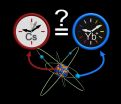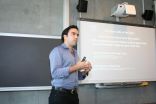Gravity may have saved the universe after the Big Bang, say researchers
2014-11-18
(Press-News.org) New research by a team of European physicists could explain why the universe did not collapse immediately after the Big Bang.
Studies of the Higgs particle - discovered at CERN in 2012 and responsible for giving mass to all particles - have suggested that the production of Higgs particles during the accelerating expansion of the very early universe (inflation) should have led to instability and collapse.
Scientists have been trying to find out why this didn't happen, leading to theories that there must be some new physics that will help explain the origins of the universe that has not yet been discovered. Physicists from Imperial College London, and the Universities of Copenhagen and Helsinki, however, believe there is a simpler explanation.
In a new study in Physical Review Letters, the team describe how the spacetime curvature - in effect, gravity - provided the stability needed for the universe to survive expansion in that early period. The team investigated the interaction between the Higgs particles and gravity, taking into account how it would vary with energy.
They show that even a small interaction would have been enough to stabilise the universe against decay.
"The Standard Model of particle physics, which scientists use to explain elementary particles and their interactions, has so far not provided an answer to why the universe did not collapse following the Big Bang," explains Professor Arttu Rajantie, from the Department of Physics at Imperial College London.
"Our research investigates the last unknown parameter in the Standard Model - the interaction between the Higgs particle and gravity. This parameter cannot be measured in particle accelerator experiments, but it has a big effect on the Higgs instability during inflation. Even a relatively small value is enough to explain the survival of the universe without any new physics!"
The team plan to continue their research using cosmological observations to look at this interaction in more detail and explain what effect it would have had on the development of the early universe. In particular, they will use data from current and future European Space Agency missions measuring cosmic microwave background radiation and gravitational waves.
"Our aim is to measure the interaction between gravity and the Higgs field using cosmological data," says Professor Rajantie. "If we are able to do that, we will have supplied the last unknown number in the Standard Model of particle physics and be closer to answering fundamental questions about how we are all here."
INFORMATION:
The research is funded by the Science and Technology Facilities Council, along with the Villum Foundation, in Denmark, and the Academy of Finland.
ELSE PRESS RELEASES FROM THIS DATE:
2014-11-18
WINSTON-SALEM, N.C. - Nov. 18, 2014 - Although every person's DNA remains the same throughout their lives, scientists know that it functions differently at different ages.
As people age, drastic changes occur in their DNA methylation patterns, which are thought to act as a "second code" on top of the DNA that can lock genes in the on or off position. However, what the consequences of these changes are remains a mystery.
To begin deciphering this process, scientists at Wake Forest Baptist Medical Center studied methylation patterns in the blood cells of 1,264 persons ...
2014-11-18
This news release is available in German.
Are the fundamental constants really constant? Recent investigations carried out at the Physikalisch-Technische Bundesanstalt (PTB) have shown that one essential fundamental constant - namely the mass ratio of protons to electrons - can have changed only by a maximum of one part in a million over the age of our solar system (i.e. extrapolated over approx. 5 billion years). Previously, scientists deemed the possible changes to be twice as high. To obtain this result, physicists from PTB compared caesium and ytterbium atomic ...
2014-11-18
Spices and herbs are rich in antioxidants, which may help improve triglyceride concentrations and other blood lipids, according to Penn State nutritionists.
Triglyceride levels rise after eating a high-fat meal -- which can lead to an increased risk of heart disease. If a high-antioxidant spice blend is incorporated into the meal, triglyceride levels may be reduced by as much as 30 percent when compared to eating an identical meal without the spice blend. The spiced meal included garlic powder, rosemary, oregano, cinnamon, cloves, paprika, turmeric, ginger and black pepper.
Sheila ...
2014-11-18
Scientists have discovered how a gene mutation can lead to diseases that occur when the immune system attacks the body by mistake.
Understanding how these mechanisms work could help scientists to develop new treatments for autoimmune diseases such as Lupus and neurodegenerative conditions including Motor Neurone Disease.
Researchers found that a mutation in the gene - called ADAR1 - causes a defect in an alarm system in our cells that normally protects the body from viruses and other infections. This means that the alarm system is tripped by the cell's own molecules, ...
2014-11-18
A new method for examining the Ebola virus genome could make surveillance quicker and cheaper for West African nations, and help detect new forms of the virus. The detailed procedure is being shared with the research community along with the study paper, which is freely available in the open access journal Genome Biology.
With over 13,000 cases and nearly 5,000 deaths in eight affected countries, the current Ebola outbreak in West Africa is the largest to date, the first to spread to densely populated urban areas, and represents the first time the virus has been diagnosed ...
2014-11-18
Celiac disease patients suffer from gluten intolerance and must adjust to a life without gluten from food sources like wheat, rye and barley. There is no treatment of the disease except lifelong gluten-free diet, but now a Danish/Norwegian research team publishes new research, that may lead to the development of a drug against the disease.
Gluten intolerance is often caused by celiac disease, which makes the human organism sensitive to gluten proteins from certain cereals. No known drug can cure the disease or make the patient able to eat gluten again, and therefore the ...
2014-11-18
A new study has shown for the first time how people can be trained to "see" letters of the alphabet as colours in a way that simulates how those with synaesthesia experience their world.
The University of Sussex research, published today (18 November 2014) in Scientific Reports, also found that the training might potentially boost IQ.
Synaesthesia is a fascinating though little-understood neurological condition in which some people (estimated at around 1 in 23) experience an overlap in their senses. They "see" letters as specific colours, or can "taste" words, or ...
2014-11-18
Researchers at the Bellvitge Biomedical Research Institute (IDIBELL) and doctors at University Hospital of Bellvitge, together with a team of researchers from the University of California, Cincinnati Children's Hospital, California Pacific Medical Center, University of Pittsburgh, University Emory and Stanford University (USA) and the Children's Hospital of Mexico Federico Gomez, have developed a genetic test that identifies patients at high risk of kidney transplant rejection. From a peripheral blood sample and test development easier, you can tell noninvasively and before ...
2014-11-18
For years physicists have been looking for the universe's elusive dark matter, but so far no one has seen any trace of it. Maybe we are looking in the wrong place? Now physicists from University of Southern Denmark propose a new technique to detect dark matter.
The universe consists of atoms and particles - and a whole lot more that still needs to be detected. We can only speculate about the existence of this unknown matter and energy.
"We know that app. 5 pct. of the universe consists of the known matter we are all made of. The rest is unknown. This unknown matter ...
2014-11-18
In 1966, it was Roger Penrose who won the prestigious Adams Prize for his essay "An analysis of the structure of space-time." The Adams Prize - named after the British mathematician John Couch Adams - is awarded each year by the Faculty of Mathematics at the University of Cambridge to a young, UK-based mathematician. At the same time, Steven Hawking won an auxiliary to the Adams Prize for an essay entitled Singularities and the Geometry of Spacetime, shortly after completing his PhD. A copy of the original Hawking submission has now been reproduced in EPJ H.
That year, ...
LAST 30 PRESS RELEASES:
[Press-News.org] Gravity may have saved the universe after the Big Bang, say researchers

